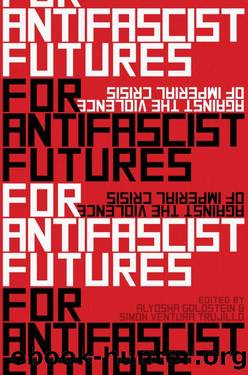For Antifascist Futures by Alyosha Goldstein & Simón Ventura Trujillo

Author:Alyosha Goldstein & Simón Ventura Trujillo [Goldstein, Alyosha & Trujillo, Simón Ventura]
Language: eng
Format: epub
ISBN: 9781942173564
Publisher: Common Notions
Published: 2022-04-25T18:30:00+00:00
CHAPTER ELEVEN
Claudia Jones, the Longue Durée of McCarthyism, and the Threat of US Fascism
Charisse Burden-Stelly
Fascism from Hitlerism to McCarthyism
On December 5, 1955, the United States government ordered the deportation of Claudia Jones, a prolific leader and theorist in the Communist Party of the United States of America (CPUSA), who, though Trinidadian by birth, had spent most of her life stateside.1 Her expulsion was the culmination of years of harassment, surveillance, and state repression, primarily under the auspices of the Alien Registration Act of 1940 (Smith Act) and the Internal Security Act of 1950 (McCarran Act). This anticommunist violence experienced by Jones and her fellow party members was one aspect of what she feared was the rise of fascism in the United States. After World War II, Jones theorized, the threat of US fascism was manifested in the rise in white supremacist terrorism, especially against Black people; the entrenchment of âWall Street imperialism,â which included the subjugation of labor domestically and economic domination internationally; warmongering and militarism; and, of course, the governmentâs utilization of anticommunism to crush the CPUSA and to cripple all progressive thought and activism. As the National Committee to Defend Negro Leadership argued in 1955, Jones was being persecuted because she fought against the âfascist-like abuses of the Negro people in the South,â because she fought for world peace, and for her political views in general. Jonesâ âforcible ejection,â the Committee reprimanded, exemplified âthe continuing abuse of the rights of colored people by the use of anti-Communist hysteriaââa practice that had been a cornerstone of Adolf Hitlerâs Germany in the nottoo-distant past.2
Jonesâ postwar antifascism is not surprising given that it was the spread of fascism in the 1930s that drew her to the CPUSA. In particular, she was impressed by how the Party spoke about the linked fates of Africans who were menaced by fascist Italy and African Americans who were terrorized by white supremacy. âI was impressed by the Communist speakers,â she wrote to her comrade William Z. Foster in 1955, âwho explained the reasons for this brutal crime against young Negro boys [the Scottsboro Nine]; and who related the Scottsboro case to the struggle of the Ethiopian people against fascism and Mussoliniâs invasion.â3
When the Italian fascist Benito Mussolini ordered the invasion of Abyssinia on October 3, 1935, anticapitalist activists, organizers, and intellectuals throughout the African diaspora immediately connected this aggression against one of the only African countries that had evaded colonial rule to European colonialism, white supremacy in the United States, Euro-American imperialism, and world war.4 As long as Africans continued to be treated as inferior âothersâ to be ruled by Europeans, the Pan-African Marxist George Padmore contended, the threat of fascist tyranny would always be present.5
As early as 1934, the International Trade Union Committee of Negro Workers (ITUCNW), founded in July 1928 during the Sixth Congress of the Communist International, appealed to the global proletariat to rally against Italyâs war provocations. Every subsequent issue of the ITUCNWâs newspaper, The Negro Worker, defended Abyssinian sovereignty, condemned
Download
This site does not store any files on its server. We only index and link to content provided by other sites. Please contact the content providers to delete copyright contents if any and email us, we'll remove relevant links or contents immediately.
| Coloring Books for Grown-Ups | Humor |
| Movies | Performing Arts |
| Pop Culture | Puzzles & Games |
| Radio | Sheet Music & Scores |
| Television | Trivia & Fun Facts |
Paper Towns by Green John(4785)
Spare by Prince Harry The Duke of Sussex(4774)
Machine Learning at Scale with H2O by Gregory Keys | David Whiting(3564)
Never by Ken Follett(3509)
Learning C# by Developing Games with Unity 2021 by Harrison Ferrone(3281)
Fairy Tale by Stephen King(2921)
Fantastic Beasts and Where to Find Them: Illustrated edition by J.K. Rowling & Newt Scamander(2917)
The Man Who Died Twice by Richard Osman(2794)
Reminders of Him: A Novel by Colleen Hoover(2731)
How The Mind Works by Steven Pinker(2607)
0041152001443424520 .pdf by Unknown(2589)
Will by Will Smith(2568)
Fantastic Beasts and Where to Find Them: The Original Screenplay by J. K. Rowling(2409)
The God delusion by Richard Dawkins(2176)
Rationality by Steven Pinker(2145)
Borders by unknow(2114)
Never Lie: An addictive psychological thriller by Freida McFadden(2072)
The Dawn of Everything: A New History of Humanity by David Graeber & David Wengrow(2005)
It Starts With Us (It Ends with Us #2) by Colleen Hoover(2000)
